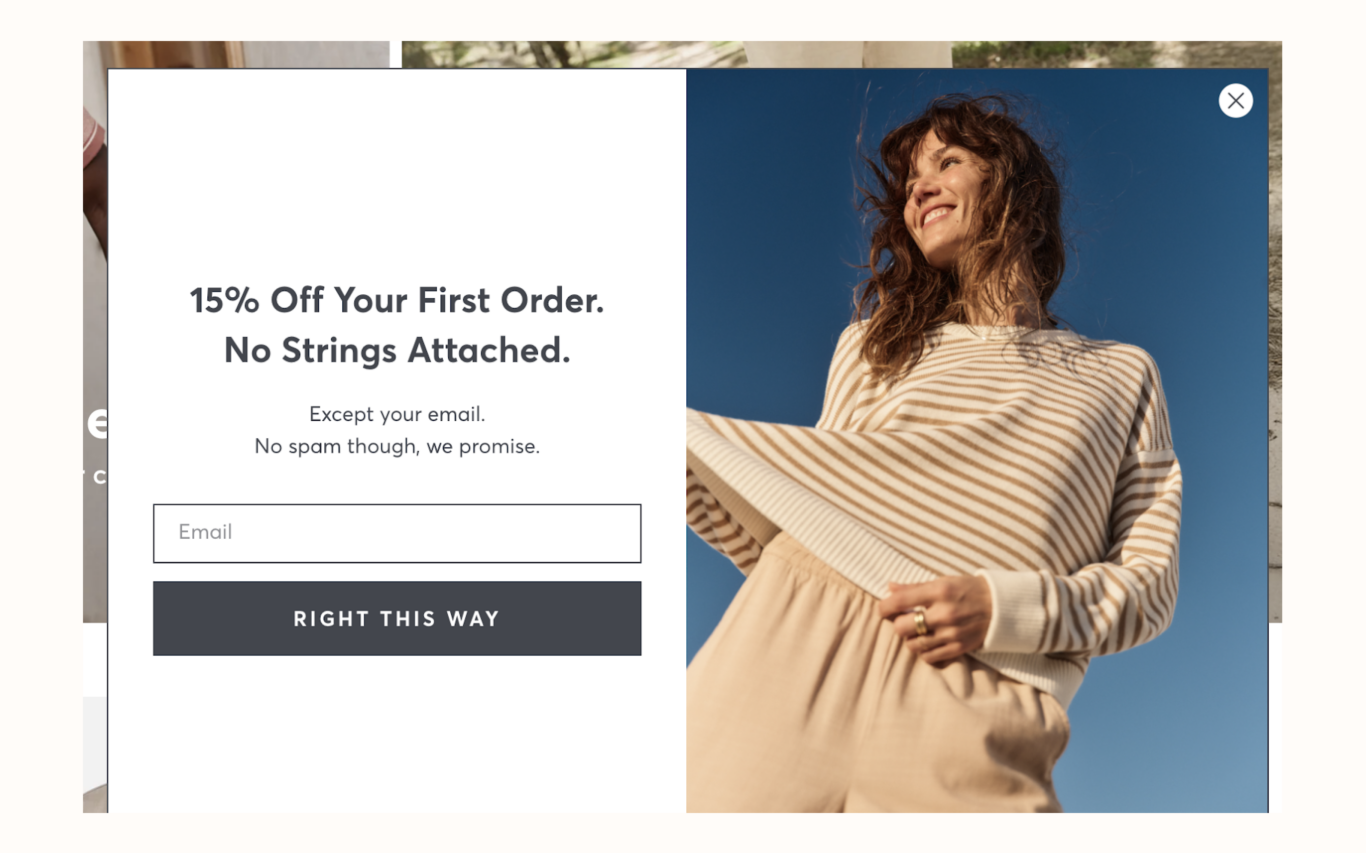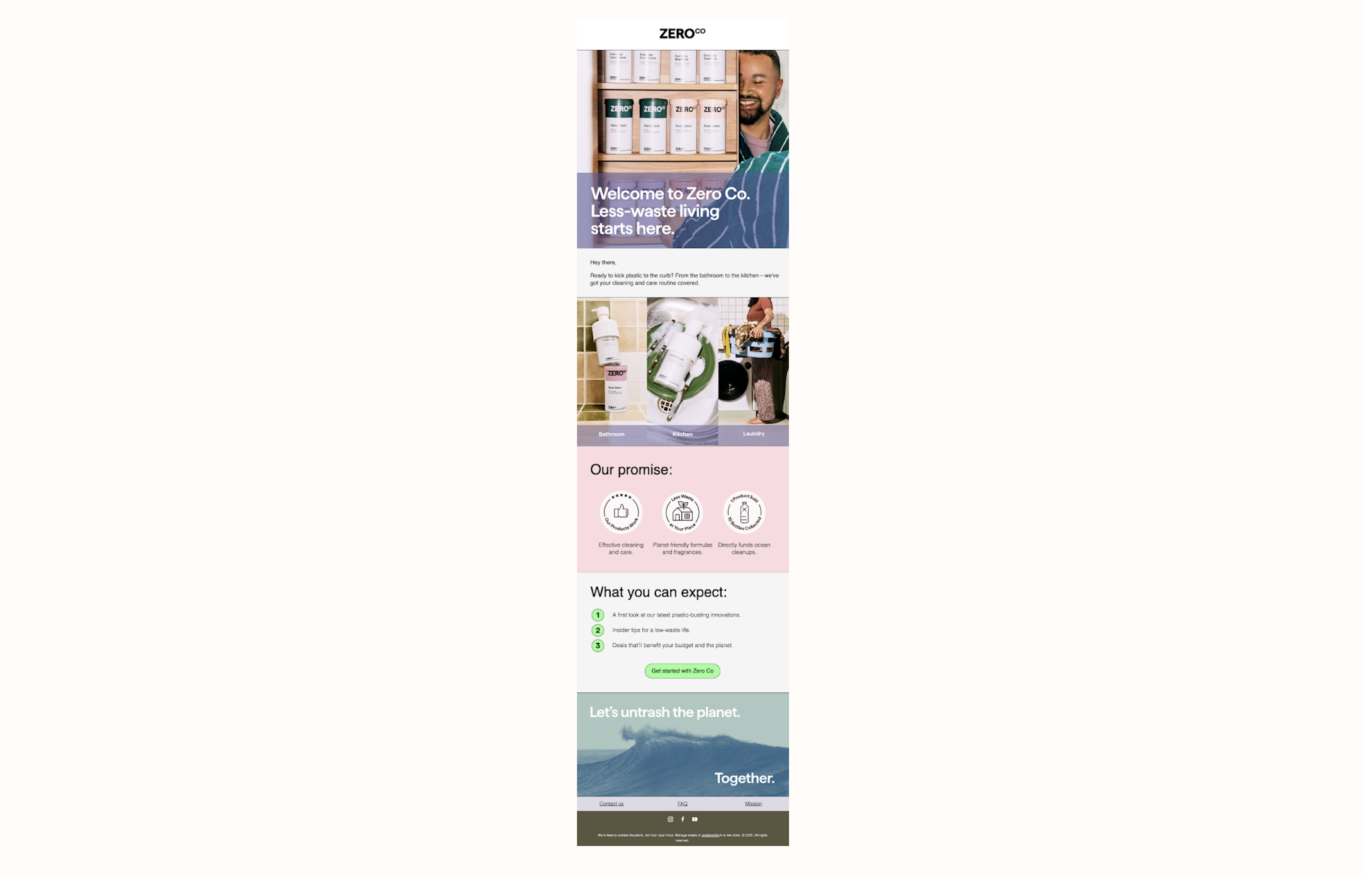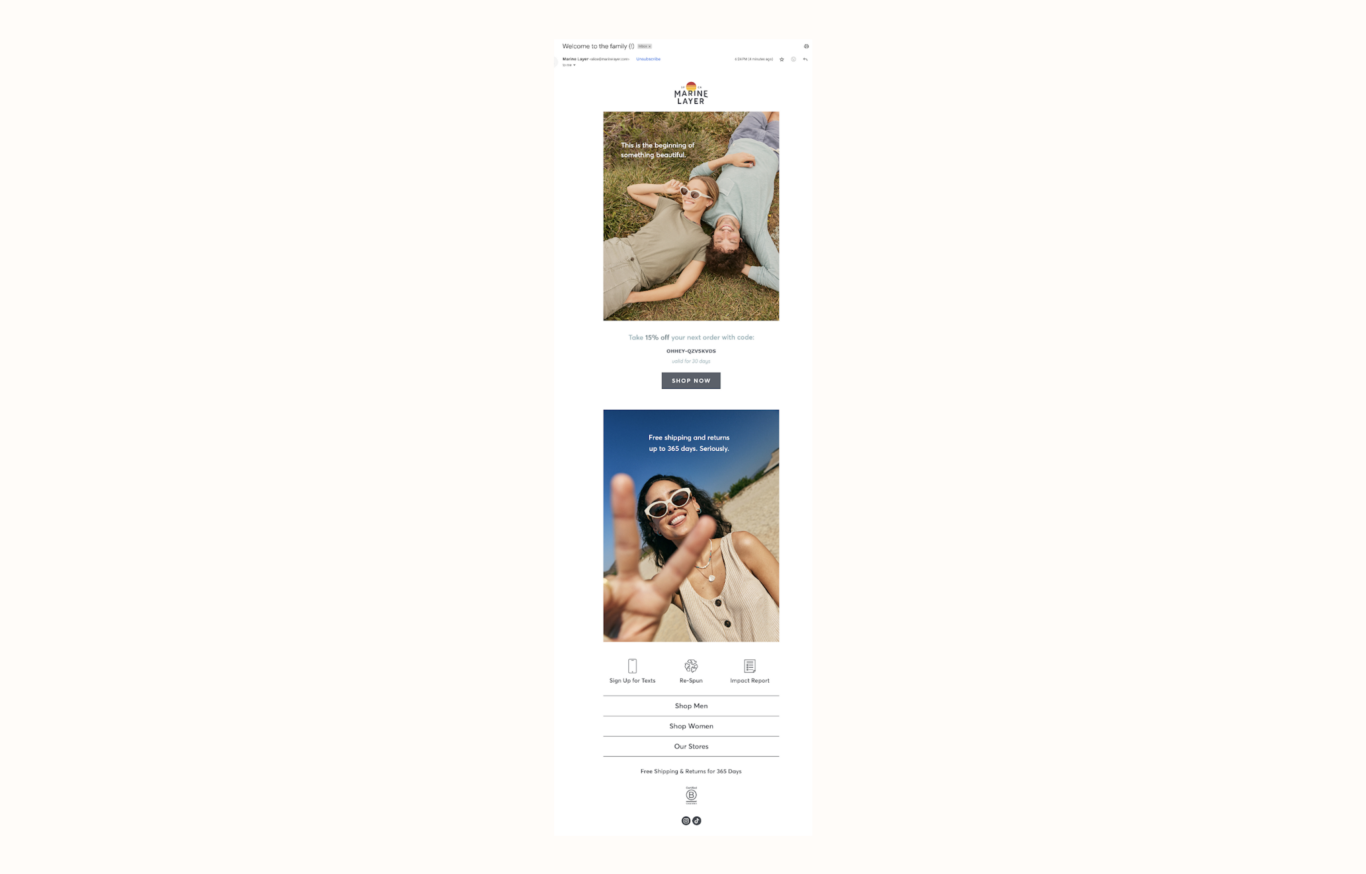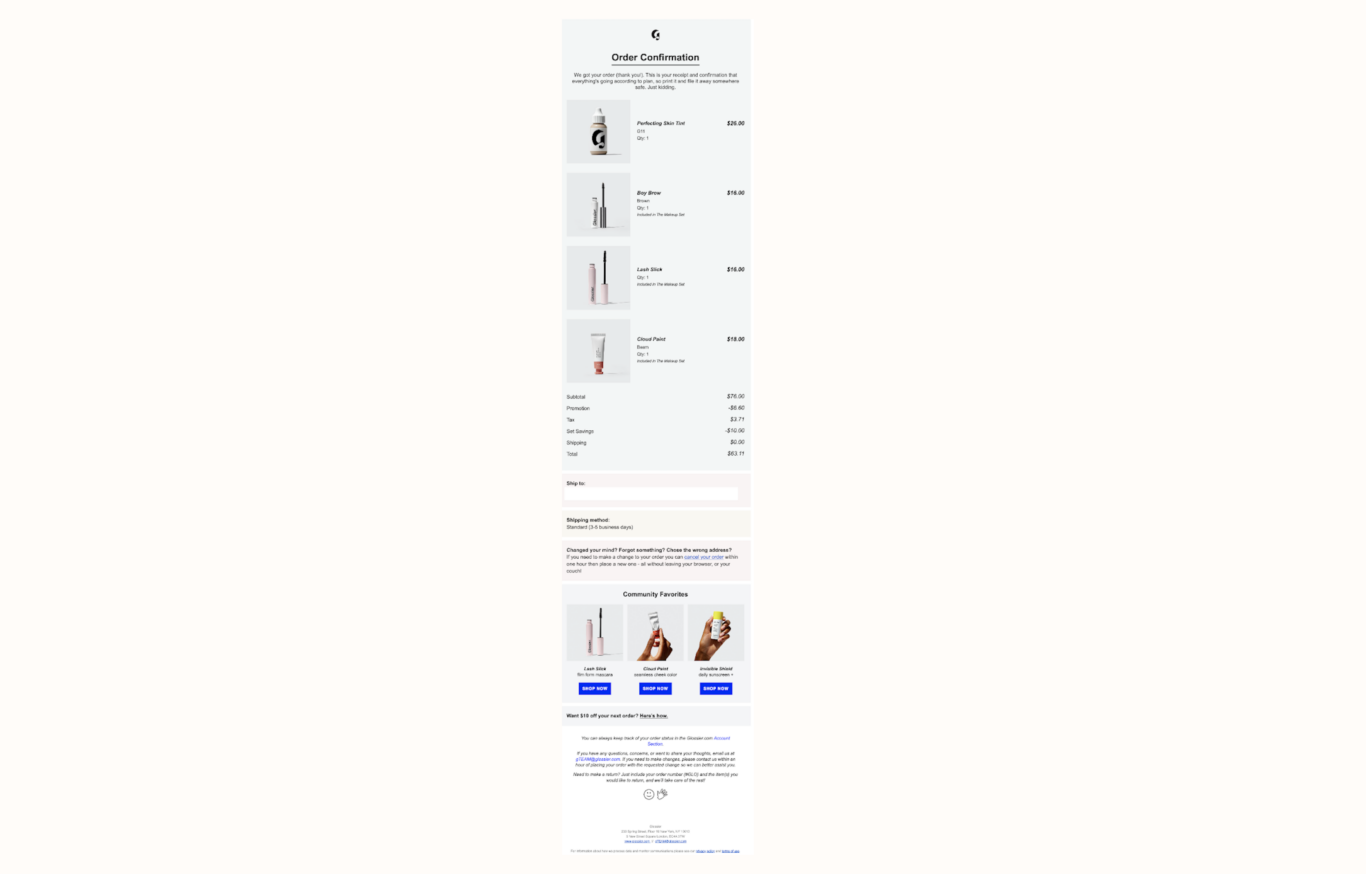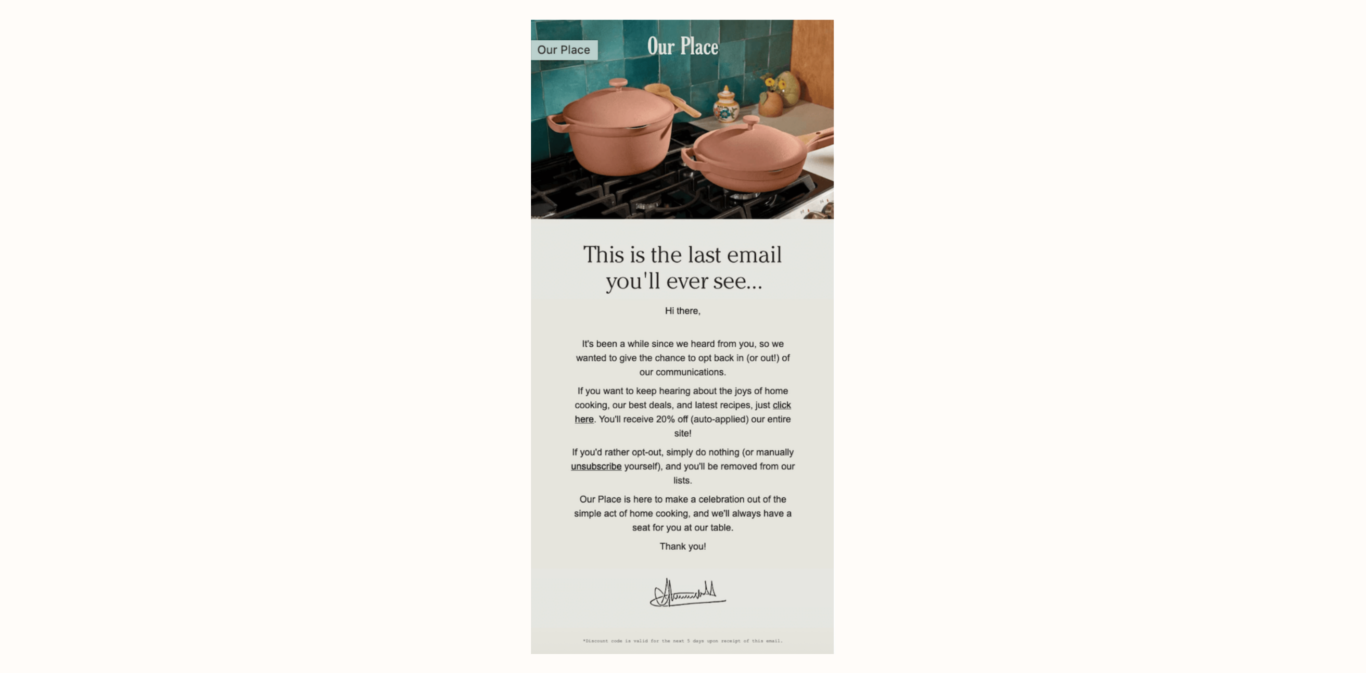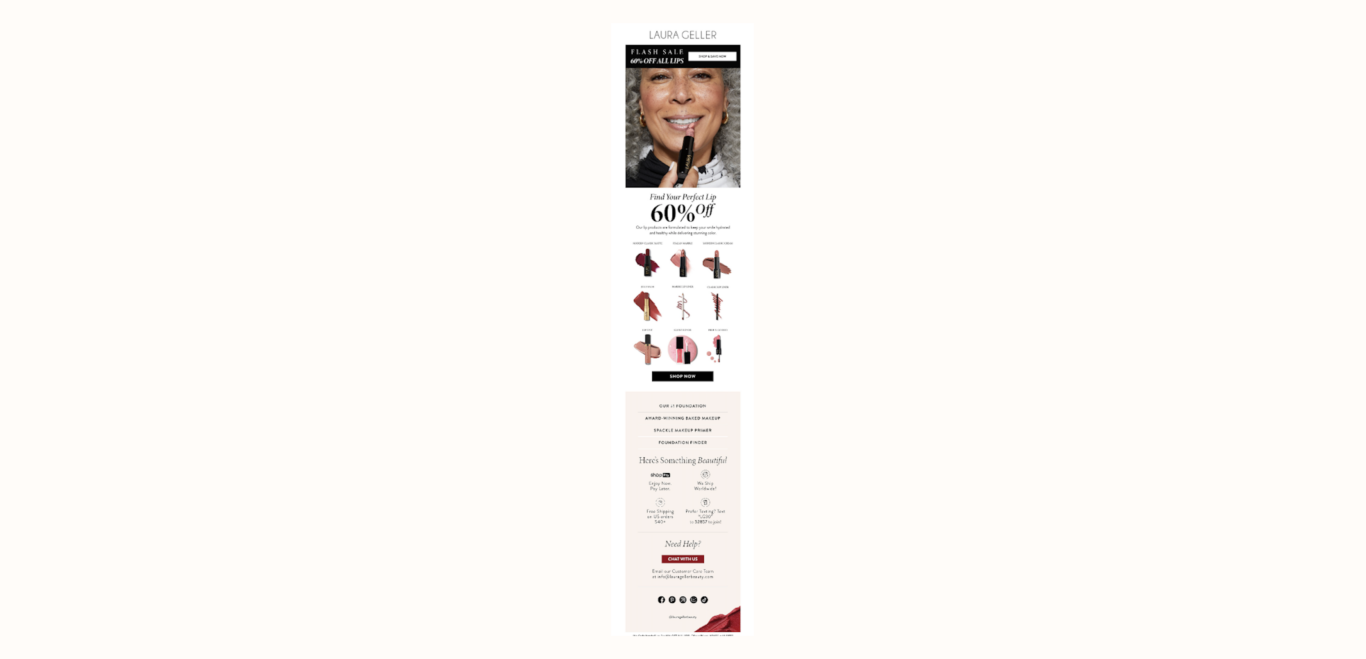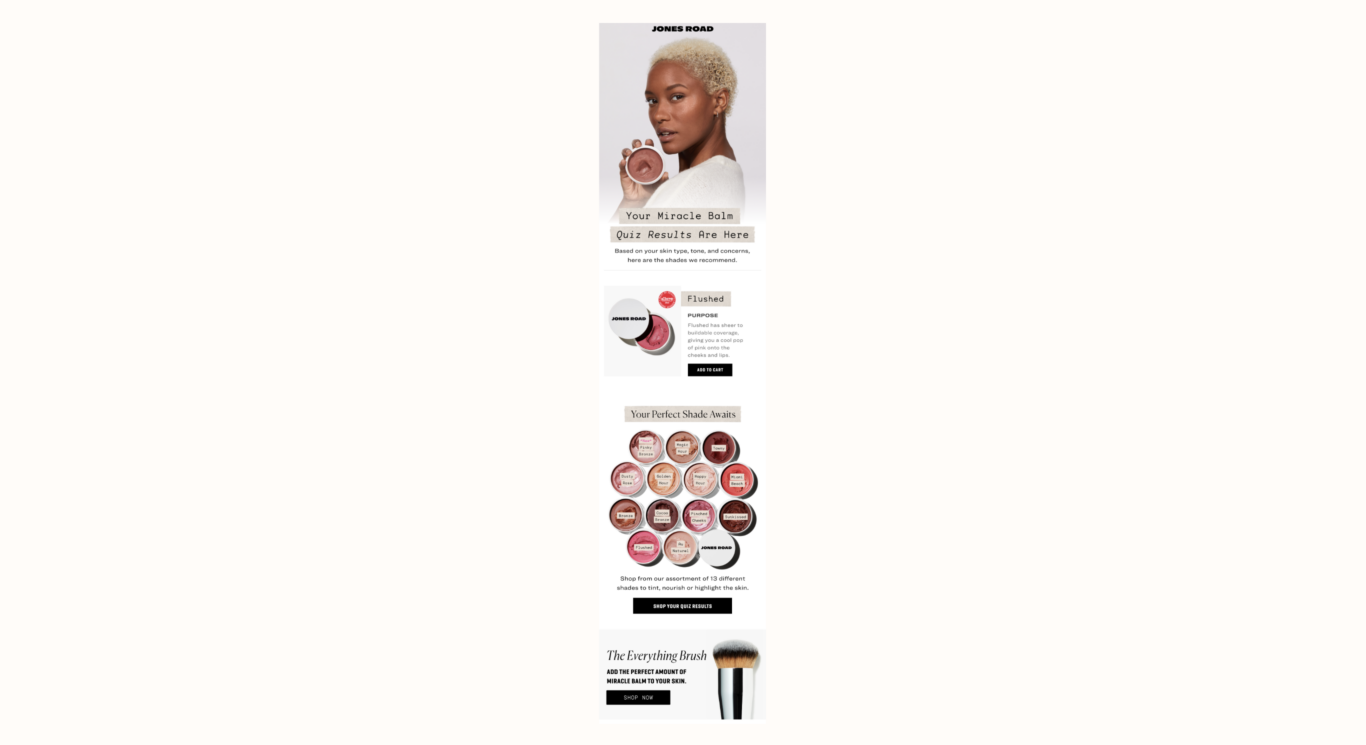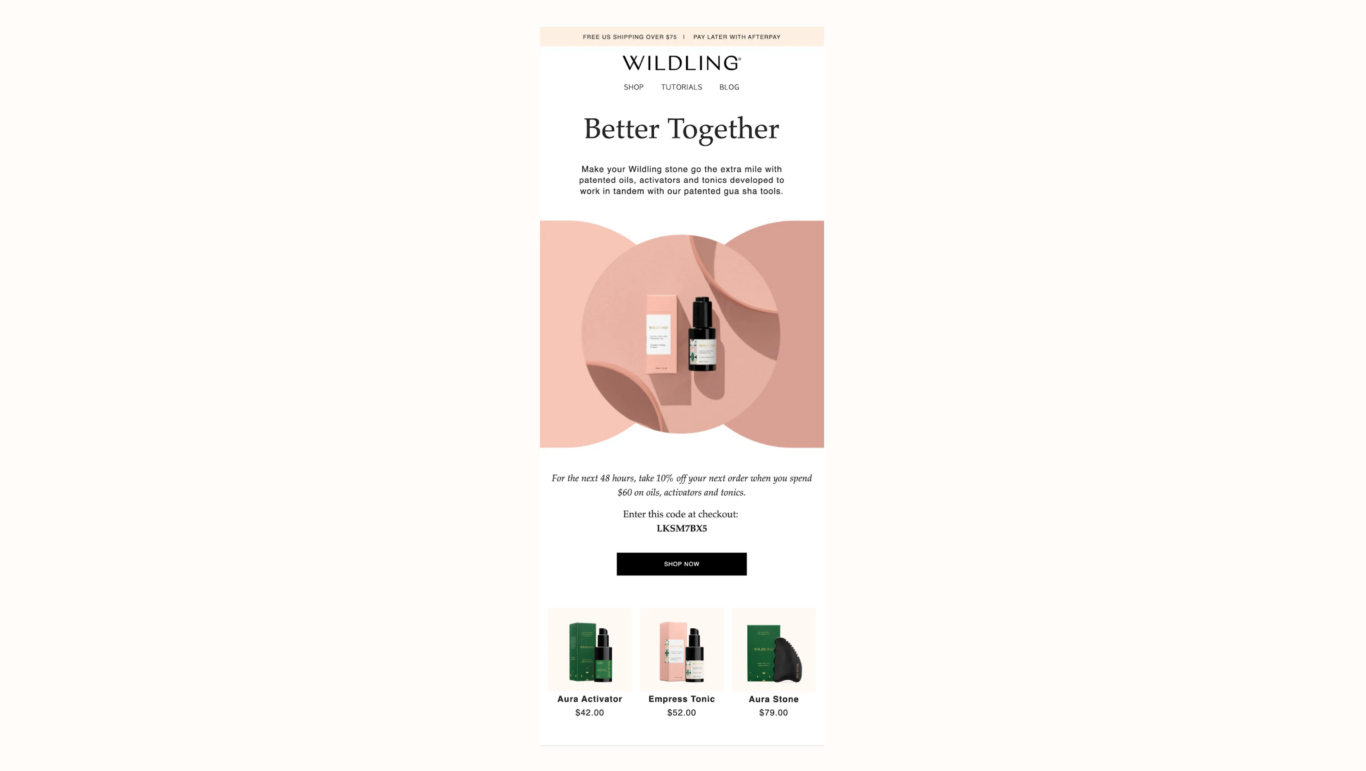The email marketing guide for ecommerce
How to engage customers, build relationships, and generate ecommerce sales with email marketing
Summary
Email marketing strategy for ecommerce brands in 2025
The data you own is the data you learn from.
For ecommerce businesses that want to build close relationships with customers, email marketing is a window to the souls of your audience—what speaks to them, what fulfils their needs, and what journey they need to take before making a purchase.
Email marketing not only generates a high return on investment for a lower cost than paid channels like social and ads—it’s also a channel for 1:1 personalised communication. This is huge for ecommerce businesses, which handle thousands or even millions of customers every year, and simply cannot nurture all those relationships manually.
This guide will help you build an ecommerce email marketing strategy and connect with more customers to grow your ecommerce business in 2025.
Why email marketing drives ecommerce success
Email marketing delivers significant ROI among digital channels
According to Statistica, email marketing in the UK earns £38 for every £1 spent.
Think of it this way: a social media follower interacts with your brand passively, but an email subscriber has indicated higher intent by actively requesting more information from your brand. Even if they don’t buy, they’re less likely to ignore your messages than someone scrolling their feed.
Cameron Faist, VP of growth at Aura Bora, has experienced this firsthand. “There’s a cost to Klaviyo, but nowhere near the tens of thousands of dollars Facebook and TikTok ads cost,” Faist says. “When we’re increasing our campaign sends, that revenue has no cost associated with it. We look at Klaviyo as a no-cost channel. We absolutely saw a better P&L for our DTC side of the business as a result.”
Email programs build valuable data and strong customer relationships
Apple’s data privacy changes wiped out many audience-identifying parameters that marketers used to rely on to reach customers and prospects with retargeting ads across paid social and display ads.
As an owned channel that doesn’t rely on an algorithm or pay-to-play campaigns, email helps you collect zero- and first-party data and communicate directly with your audience.
• Zero-party data is information someone proactively gives you, like their email address, phone number, or birthday.
• First-party data is information you collect or observe about your audience, like which pages someone has viewed on your website.
With enough customer-provided and behavioural data, you can segment your email list and tailor your communication, creating a level of granular targeting that other channels can’t compete with.
Using behavioural targeting and zero-party data, “you’re actually mapping what the customer has done and has demonstrated interest in, even if they’ve never told you about it,” says Lucina Kress Rowe, principal customer success manager at Klaviyo.
How to get started with ecommerce email marketing
1. Choose the right email marketing platform
The best email marketing tools are email builders, but they’re also:
• Customer data platforms (CDPs)
• Customer relationship management platforms (CRMs)
• Segmentation and list managers
• Sign-up form builders
• Email template repositories
• Email automation tools
• A/B testing deployers
• Analytics platforms
Choose a solution that comes with loads of integrations with essential ecommerce tools, like your online store, customer helpdesk, payment platform, loyalty program, and more.
2. Start building your list
Start building your email list by collecting email addresses through forms across your website that offer exclusive discounts, early access to new products, or a behind-the-scenes look at what your company is working on.
3. Segment your audience
The era of batch-and-blast is over. Today’s best email marketers default to audience segmentation based on:
• Website behaviour
• Marketing engagement
• App activity
These lists should be dynamic—meaning subscribers automatically move to new segments based on their activity.
4. Build your first automated flows and campaigns
The top 10% of email campaigns earn an average 4.74% click rate across all industries, according to Klaviyo’s latest email marketing benchmarks. Email automations, meanwhile, drive revenue while you sleep. Both are key parts of a cohesive email marketing strategy.
Email campaigns are an opportunity to share new product releases, VIP program updates, or founder updates. The top 10% of email campaigns generate an average of $0.97 in revenue per recipient (RPR), per Klaviyo’s latest email marketing benchmarks.
Triggered by actions your subscribers take, automated flows are capable of nurturing millions of 1:1 relationships. Personalise these automations based on real customer data to avoid generic, cookie-cutter messaging.
5. Implement ongoing optimisation strategies
Email marketing optimisation isn’t a one-time initiative. It’s an ongoing practice. Continual iteration and improvement are the name of the game.
To stay organised, create a testing calendar to help your team track planned, active, and completed tests.
Monitoring is essential. Build key dashboards and reports that track metrics for your program and current experiments too. Monitor leading and lagging indicators so you can identify potential issues as early as possible.
6 email marketing strategies for ecommerce brands
1. Create a compelling sign-up form
Target new and returning visitors, customers who have abandoned shopping carts, and existing carts with email sign-up forms. These can be multi-step, meaning the first “page” of the form asks for an email address while the next asks for a phone number, and they can be triggered by specific user behaviours, like exiting a page or scrolling to a certain page percentage.
Types of email sign-up forms
Here are the most common types of sign-up forms:
• Full-screen forms: These display over the entire browser window. In order to continue browsing, a user must interact with the form by either Xing out of it or submitting their information (median submission rate: 3.54%).
• Pop-up forms: These appear on your website until something triggers them, whether it’s scrolling down or hovering over a link. They’re slightly less disruptive than full-screen forms—typically, the visitor can still see the rest of your website in the background (median submission rate: 2.71%).
• Fly-out forms: These forms enter the browser’s window from any direction, typically to the edge of the screen rather than the middle (median submission rate: 1.78%).
• Embedded forms: Embedded forms live on a specific page of your website, such as your footer, as static forms with an email address field and a sign-up button (median submission rate: 1.04%).
Here’s an example of a pop-up form from cozy clothing brand Marine Layer. This form entices new subscribers with a 15% first-time discount and only asks for an email address.
Image source: Marine Layer
Email sign-up incentives that work
According to Klaviyo’s future of consumer marketing report, here’s why people sign up for ongoing updates from ecommerce brands:
1. Exclusive discounts or promotional offers: 43%
2. Early access to sales, new products, or events: 19%
3. Personalised recommendations: 13%
When building your email sign-up forms, find the right offer for your audience and marketing goals. Think about whatever might be valuable to your audience based on where they are in their journey with your brand, and who they are as people.
Discounts are a popular and obvious choice, here, but you might also consider:
• Content-based offers: a PDF download or guidebook
• Free gifts: a free item or sample with their first purchase
• Free shipping: a welcome shipping offer or exclusive free shipping for subscribers
• Contests or giveaways: a chance to win a prize pack or free item
2. Thoughtfully segment your customers and prospects
Segmentation is a powerful way for ecommerce businesses to manage massive lists, treating each recipient like a real person with a unique relationship to your brand. Here are some ways to segment:
• Demographic segmentation: age, income, occupation, gender, etc.
• Geographic segmentation: shipping or billing addresses, preferred retail location, etc.
• Behavioural segmentation: purchase history or frequency, category affinity, browsed product pages, engagement with emails or SMS messages
• Psychographic segmentation: customer interests, customer values, lifestyle preferences
• Technographic segmentation: operating system, device type
July, a travel brand, sent targeted emails to customers close to their Australian retail locations to promote a new product available in-store. These highly personalised messages contributed to 52% YoY growth in Klaviyo-attributed revenue.
3. Craft high-converting ecommerce emails that drive action
Good design is subjective. What works for one brand may not work for yours, so A/B test various elements of your email design to find out what works.
Email design elements that engage readers
Email templates should adhere to basic principles, and include:
• A heading
• A hero image
• A short blurb
• Call-to-action (CTA) buttons (no more than 3)
• Your logo and social media links
• An unsubscribe link—it’s the law
• Images, but not so many that your email loads slowly
• Colourful or patterned backgrounds
“Design for mobile first,” says Ben Zettler, founder at Zettler Digital. “Most people are opening emails on their phones, and mobile formatting works on desktop anyway.”
Subject line strategies that increase open rates
Your subject line is your email’s first impression, so it matters—a lot. A/B test subject lines with 5–10% of your list before sending a campaign wide. Personalise subject lines to make them more relevant, and keep them between 50–70 characters so recipients can see them in the preview.
Copywriting that sells
Last but certainly not least is your body copy, which should communicate your product’s value proposition and key benefits, and use your brand’s voice and tone.
4. Use smart email automations to drive engagement and revenue
Automated flows like abandoned cart or post-purchase messages generate up to 30x more RPR than email campaigns because they’re timely and targeted, according to Klaviyo’s latest email marketing benchmarks. Here are the fundamental ecommerce automations to implement:
Welcome emails that encourage engagement
A welcome email series is a sequence sent to new subscribers when they join your email list. Welcome emails generally fall into 4 categories: educational, first-purchase discount, product recommendations, and data gathering.
According to Klaviyo’s latest email benchmarks, welcome emails average a 1.97% placed order rate, while the top 10% convert at 9.89%.
This welcome email from refillable essentials brand Zero Co reiterates the brand mission, and gives an overview of what types of emails subscribers can expect.
Image source: Zero Co
Similarly, Marine Layer uses their welcome email to give every new subscriber a discount code, and highlights a key brand differentiator—free shipping and returns for 365 days.
Image source: Marine Layer
Abandonment emails that recover lost sales
Browse abandonment emails go out when subscribers browse your website but leave without adding an item to their shopping cart, while abandoned cart emails go out when shoppers add products to their carts but don’t purchase them.
70% of online shopping carts are abandoned, according to the Baymard Institute. If you’re not sending abandonment emails that nudge shoppers to buy, you’re leaving a lot of money on the table.
According to Klaviyo benchmarks, abandoned cart flows drive the highest average RPR ($3.07) and placed order rate (2.68%) of all flows, while browse abandonment emails pull in 10x higher conversion rates than a standard email campaign.
Abandonment emails are your second chance to encourage someone to buy, whether it’s through:
• Showing more benefits
• Comparing your product to a competitor
• Highlighting a customer testimonial
• Sending a special offer
An abandonment sequence might involve 3 emails: a reminder after 2–4 hours, a follow-up with a discount after 24 hours, and a final message after 48 hours that includes alternative product recommendations or asks for feedback.
Manly Bands, a wedding ring company, sends an abandoned cart survey flow that asks subscribers why they didn’t buy. The placed order rate for this flow was 4.8x the median for Manly Bands’ peer group, according to Klaviyo benchmarks.
Post-purchase flows that encourage reviews and repeat buys
Post-purchase flows—including transactional emails like order confirmations and shipping confirmations, but also emails like up- and cross-sells and review requests—have an average 59.77% open rate and 0.48% placed order rate, according to Klaviyo’s latest email marketing benchmarks. These flows not only provide essential information to customers, but can also generate cross-sells.
Transactional emails can include return confirmations, account creation emails, subscription confirmations, and anything that’s not a marketing or educational email. These emails are a form of good customer service. They also prevent customers from calling your service reps to clarify details of their order, essential deflection for high-volume ecommerce businesses.
If most of your customers are in Europe, transactional emails need to comply with GDPR, and be pretty bare-bones. But in the US, they can also be an opportunity to nurture customers beyond a sale.
Educational post-purchase emails can include educational content and video tutorials on how to use or style a product, or user-generated content (UGC) that acts as social proof to reaffirm someone’s decision to buy.
Cross- or up-sell emails can include personalised product recommendations based on the customer’s initial purchase.
Review requests generate social proof and feedback. Our future of consumer marketing report found that other customers’ reviews are the primary way ecommerce buyers make purchasing decisions, so they’re a huge lever for growth. When soliciting reviews, make sure you’ve given your customers time to see value from their products.
Beauty brand Glossier’s order confirmation email clearly displays each item purchased, along with product recommendations and a link to receive a discount on the next order.
Image source: Glossier
Win-back campaigns that reactivate dormant customers
Ecommerce growth hinges on turning one-time customers into repeat buyers, and win-back flows re-engage dormant customers without being disruptive.
To define what “dormant” means for you, analyse customer data. If your typical engaged customer places 4 orders a year, for example, dormancy might mean someone who hasn’t bought in 6 months.
To pick the right win-back incentives, consider types of dormancy, too. Customers who don’t open emails are different from those who do but don’t click through, or those who browse but don’t buy. You can segment these customers and build different flows for each segment, or you can include multiple CTA types in one flow so buyers can take the most relevant action.
Here’s an eye-catching email marketing example from cookware brand Our Place. The email contains a discount, and directly asks the reader whether or not they want to continue receiving marketing communications.
Image source: Our Place
5. Integrate email with other ecommerce marketing channels
Extend your email marketing by using it alongside other marketing channels that unlock the power of your customer data, like:
• SMS: Make sure your email and SMS channels are integrated so you don’t send duplicate or excessive content. Use SMS messages for quick, timely announcements and emails for longer-form content like newsletters.
• Social media: The future of consumer marketing report found that 29% of consumers discover new ecommerce brands through organic social media, and another 10% do so via influencers’ social content. Drive new email sign-ups from social media, and incorporate social posts in your email marketing.
6. Measure ecommerce email marketing success
To understand how email is doing as a channel, and how emails are contributing to overall business growth, track email marketing metrics like:
• Open rate: the percentage of recipients who open an email (note this metric is less reliable post-iOS 15 changes)
• Click rate: the percentage of recipients who click on a link in an email
• Conversion rate: the percentage of recipients who purchase after they click on an email
• Deliverability rate: the percentage of your emails that land in your recipients’ inboxes
• RPR: the total amount of revenue your email generates divided by total email deliveries
• Unsubscribe rate: the percentage of people who receive your email, then unsubscribe from your list
Use email analytics to regularly see your email program’s health and measure deliverability rates and unsubscribe rates as you ramp up email sends to a larger audience. Over time, you’ll want to get smarter about your emails, and make each send count even more by testing your content, timing, and segments.
The golden rule of A/B testing is to test only one element at once. If you’re testing subject lines, don’t test CTAs too—the double variable will skew your results, and you won’t know what’s responsible for an improvement or drop in performance.
Creative email campaign ideas for ecommerce brands, with examples
Seasonal promotions
Subject line: Spring Break plans? We’ve got a gift for you
Email content: Beauty brand Glossier promotes a makeup set that comes with a free beauty bag. The email also contains a 5-star customer review of the free bag that highlights its features and value.
Email CTA: Glossier uses one CTA in 3 places so customers can navigate to the set at any point while they scroll.
Flash sales
Subject line: Lipstick Lovers Flash Sale ⚡ 60% OFF
Email content: Makeup brand Laura Geller promotes a flash sale with a personalized content block featuring 9 products based on the recipient’s shopping history that feature a variety of product types and shades.
Email CTA: The primary CTA is to shop the flash sale, but the email also features easy-to-shop links to the brand’s other product lines and a prompt to sign up for SMS. This range of CTAs ensures that the recipient doesn’t have to buy lipstick to engage with the brand.
Co-branded promotions with partner brands
Subject line: An exclusive offer from TOMS
Email content: Personal grooming company Dollar Shave Club offers a 20% discount on TOMS shoes. Co-marketing is a clever way to reach new customers that have complementary interests or shopping habits.
Email CTA: The only CTA is to shop men’s new arrivals on the TOMS website, which reflects Dollar Shave Club’s male customer base.
Quiz results
Subject line: We have your Miracle Balm quiz results
Email content: Makeup brand Jones Road Beauty has product quizzes on their website so prospective customers can identify their perfect makeup shade. To get their results, shoppers must enter their email address. It’s a smart spin on the traditional email sign-up form.
Email CTA: After completing the quiz, customers are prompted to purchase their perfect shade of Miracle Balm, based on their results.
Image source: Jones Road Beauty
Cross- and up-sell emails
Email content: Wildling, a skincare brand, recommends products that customers often use with the brand’s gua sha tool.
Email CTA: The primary CTA takes subscribers to Wildling’s shop page, with secondary CTAs to individual products. The email header also includes links to tutorials, giving subscribers other ways to learn about the company.
Image source: Wildling
Events or in-person promotions
Subject line: YOU’RE INVITED 🥳 Join our Member’s Exclusive Sale on Feb 3 💚
Email content: Skincare brand The Body Shop advertises in-store events with exclusive free services, limited-edition products, and a free gift with certain purchases.
Email CTA: The primary CTA is to register for the event. A discount code makes subscribers who can’t attend still feel included in the festivities.
Email marketing for ecommerce FAQs
Yes, ecommerce businesses should invest in email marketing. It’s a cost-effective way to reach and engage with audiences, build customer relationships, and drive sales. Email marketing also allows ecommerce businesses to collect valuable customer data they can own and analyse, which leads to personalised communication at scale.
Build better relationships with email
Email marketing for ecommerce businesses shouldn’t be difficult. With a platform like all-in-one Klaviyo B2C CRM, you’ll be sending beautiful emails that forge customer relationships and drive conversions in no time.
Johnathan Ruggiero, co-founder and co-CEO of Manly Bands, couldn’t imagine using a different platform for his brand’s email marketing. “I’d have to buy 2–3 additional tools to replace everything Klaviyo offers,” he explains. “It’s nice that it’s all under one roof with Klaviyo, and everything’s working together. It helps us make better business decisions.”
Ready to transform your customer relationships?
Take our B2C CRM readiness assessment to discover your next steps.
How to build exceptional customer experiences
The ultimate benefit of a CRM is the customer experiences you can create.
How to improve your customer experience for higher CLV
A better customer experience should equate to more lifetime value.

